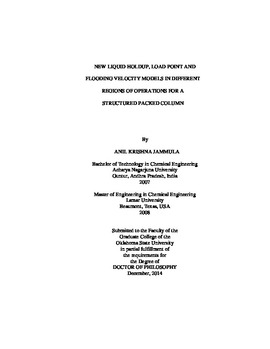| dc.contributor.advisor | Whiteley, James Robert | |
| dc.contributor.author | Jammula, Anil Krishna | |
| dc.date.accessioned | 2016-01-20T15:44:38Z | |
| dc.date.available | 2016-01-20T15:44:38Z | |
| dc.date.issued | 2014-12 | |
| dc.identifier.uri | https://hdl.handle.net/11244/25666 | |
| dc.description.abstract | Scope and Method of Study: Liquid holdup of structured packed column affects the pressure drop, flooding velocity, and HETP. For this reason, liquid holdup was used as an important model parameter by different researchers such as Billet (1999) and SRP (1995). However, despite its importance, the amount of work available on liquid holdup is much less in the open literature. When the performance of available literature models were evaluated using the experimental data from the open literature, the literature models were not properly capturing the effect of packing geometry and operating conditions. The main reason for the lack of performance is because a majority of these liquid holdup models were adopted from the random packing. So there is a clear need for liquid holdup models to be developed for a structured packed column using an experimental structured packed column. In the present work, new liquid holdup models were developed in different regions of operation using experimental data of a structured packed column. Furthermore, these new liquid holdup models were used in developing new load point and flood point models. | |
| dc.description.abstract | Findings and Conclusions: A brief summary of the new models is presented below: | |
| dc.description.abstract | Both OkState preloading and flooding liquid holdup models were developed using a film thickness model. | |
| dc.description.abstract | An OkState loading liquid holdup model was developed using vapor kinetic energy term. | |
| dc.description.abstract | An OkState load point model was developed using dimensional analysis. | |
| dc.description.abstract | An OkState flooding velocity model was developed using the Wallis equation and also liquid holdup flooding term as the main model parameter | |
| dc.description.abstract | Overall multiple models were developed using packing geometrical area and packing void fraction as the main model parameters. These new models were properly capturing the effect of operating conditions and packing geometry on the experimental conditions than any of the literature models. The current models will be useful in improving the pressure drop and HETP models of a structured packed column. | |
| dc.format | application/pdf | |
| dc.language | en_US | |
| dc.rights | Copyright is held by the author who has granted the Oklahoma State University Library the non-exclusive right to share this material in its institutional repository. Contact Digital Library Services at lib-dls@okstate.edu or 405-744-9161 for the permission policy on the use, reproduction or distribution of this material. | |
| dc.title | New liquid holdup, load point and flooding velocity models in different regions of operations for a structured packed column | |
| dc.contributor.committeeMember | Johannes, Arland H. | |
| dc.contributor.committeeMember | Cai, Tony | |
| dc.contributor.committeeMember | Bellmer, Danielle D. | |
| osu.filename | Jammula_okstate_0664D_13809.pdf | |
| osu.accesstype | Open Access | |
| dc.type.genre | Dissertation | |
| dc.type.material | Text | |
| thesis.degree.discipline | Chemical Engineering | |
| thesis.degree.grantor | Oklahoma State University | |
